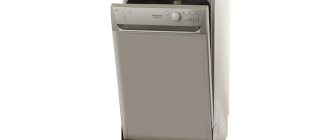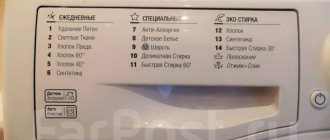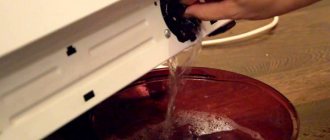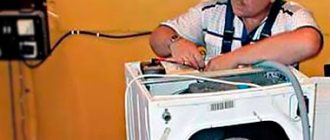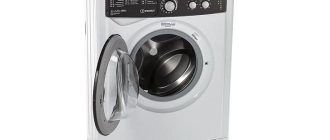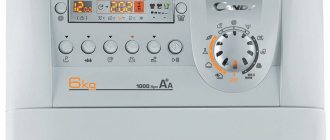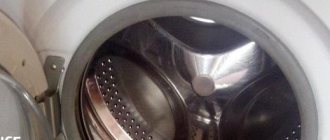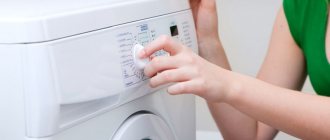Additional programs
These programs are used less frequently and are intended for certain types of fabrics and items.
Antibacterial
Divided into two types:
- Washing heavily soiled items at 90°C. Duration – 165 minutes.
- Washing colored fabrics at 60°C. Running time: 79 minutes.
In both cases, things will be pressed at maximum speed.
Night
Designed for people whose electricity and water consumption is cheaper at night than during the day. The machine washes synthetic and cotton fabrics silently at 40°C. The equipment drains the water and spins the laundry only 8 hours after the completion of the main process or at the user’s command (you need to press the “Start” button). Execution continues for 288 minutes.
Kids' things
This washing program is used if you need to wash colored and delicate items. The water heats up to just 40°C, and the technique uses increased amounts of water and several extra rinses to completely remove any detergent residue from the laundry. Running time: 116 minutes.
White things
In this mode, the device washes only light-colored fabrics at a temperature of 60°C and a spin speed of 1000 rpm.
Dark things
Used for washing dark items. The maximum permissible water temperature is 30°, laundry is spun at 800 rpm.
Silk
The most delicate mode used to wash viscose, lace fabrics, and thin curtains. No spin is used, the water is heated to only 30°C, the cycle duration is 55 minutes.
Wool
In this mode, the device washes cashmere and wool items. The water temperature reaches 40°C, the drum rotates in slow motion to prevent damage to the laundry. The number of revolutions during spinning is only 600. The cycle runs for 55 minutes.
Main programs
If the owner of the equipment wants to wash clothes, in most cases he chooses one of the main modes. The execution time below is indicated approximately; depending on the model of the Ariston machine, it may vary up or down.
Cotton
It is recommended to wash cotton fabrics on the following modes:
- Preliminary (soaking) + cotton 90°C. For heavily soiled cotton fabrics. Washing time – 164 minutes. By default, the machine spins things at maximum speed.
- Cotton 60°C. For colored and white cotton fabrics. Maximum spin, execution time – 138 minutes.
- Cotton 40°C. White or colored delicate items. The laundry is washed for 89 minutes and is spun at low speeds to prevent fabric damage.
Synthetics
Used for synthetic fabrics, temperature can be 40° or 60°C. Spin – no more than 800 rpm. Duration of execution – up to 85 minutes.
Quick wash
Depending on the model, the program is called “fast”, “express”, “mix”. Three varieties are available: 15, 30, 60 minutes. The temperature in all three cases is 30°C, spin is 800 rpm. This combination of time and temperature allows you to perfectly refresh things or wash lightly soiled clothes.
Problems with the motor or control board
If you have loaded things into the device compartment, turned on the appropriate mode and pressed the “Start” button, but the drum does not rotate, most likely the problem lies in the operation of the motor or control controller, which the display will signal to you with code F1 , F2 or F18 . Although such breakdowns can occur at any other stage of washing, they are most often displayed precisely at the start of the program.
Irregularities under code F01 (F1)
Error F01 indicates problems in the control circuit of the motor that drives the drum of the washing machine. If there is no response to a signal from the electronic controller (board), the device will not work, and when you try to switch to any other program, it will continue to persistently display a fault code.
Self-fix process:
If independent repair attempts do not lead to a positive result, the reason may lie in a breakdown or failure of the control board firmware, erased electric motor brushes, a burnt out motor winding, or damage to the cable with wires. To restore or replace these parts, it would be better to contact a service center.
Decoding signals F02, F2
This error most often occurs at the start of the program or at the spin stage, when the machine picks up speed to spin the laundry (at the same time, the drum itself may twitch or rotate intermittently). The device will display code F02 and at the same time begin to drain water.
Typically, this signal indicates a malfunction in the motor circuit or a breakdown of the tachogenerator - a small part with a ring that controls the speed of the washing machine engine.
But error F2 can also be a consequence of more serious failures, the elimination of which will require replacing the motor, tachogenerator or control board. In such cases, it is better to contact a workshop; you may be able to get by by replacing faulty solders on the control module or restoring damaged wiring.
Communication or board memory error with codes F09, F18
A signal about a malfunction of the electronic controller under code F18 can only be issued by Aristons with an asynchronous motor (models Hotpoint-Ariston, Margherita, AVSL, AV, AVL, AVTL, CDE); such errors do not occur on devices with a commutator motor.
Signs of controller malfunction:
F09 – a memory error can occur when the network voltage surges or decreases. But it may also indicate a failed control unit.
The first action after displaying codes F09 and F18 is identical to previous problems - turn off the power to the machine, give it time to reboot and turn it on again. If the reason is not a failure, it is necessary to check the board microcircuits.
Problems with water heating
If during the washing mode the washing machine freezes for a long time, stops, does not heat up, or constantly drains water, the causes of the breakdown should be sought in the heating circuit. The device will signal these problems with codes F04 , F07 or F08 .
Failure of the heating element or pressure switch and codes F04, F07
In washing modes where heating is required, the error may appear immediately after startup, or after drawing water, but rinsing or washing in cold water will work normally. In this case, there are several options for solving the problem (besides the standard turn on/off the machine to reboot the controller).
If the code appears on the display during the washing phase or during startup (the machine does not even want to draw water), most likely the reason lies in the heating element itself. It can “pierce” onto the housing when the contacts come off or simply burn out.
To fix the problem, you need to get to the heating element, check all its connections, change the resistance with a multimeter (with a power of 1800 W it should produce about 25 Ohms).
If the device collects and then immediately drains water, the cause may be a breakdown of the pressure switch - the water level sensor. If there is a problem, this element can provide the controller with information that the heating element was not immersed in water, which is why the machine does not start heating.
In this case, it is necessary to check the water pressure sensor tube with the pressure switch (the hose may become clogged, kinked, frayed, or come off). At the same time, inspect the contacts of the sensor itself - they may need to be cleaned. But more precisely, code F04 - most likely, the part will require replacement.
In some cases, the problem may be in the board itself, faulty wiring or contact groups in the area from the board to the heating element or water level sensor. Therefore, you should ring all the elements of the control unit associated with the operation of the heating circuit, and if necessary, replace the burnt tracks or the controller itself.
Heating circuit faults and F08 symbol
If the water heating does not work correctly (or the machine “seems” that it starts when the tank is empty), error code F08 . The cause is most often a malfunction in the pressure switch circuit.
This problem can occur due to high humidity in the room, which negatively affects the controller. To make sure the board is in order, inspect it, wipe it dry, or blow it with a hairdryer.
Another simple solution to the issue could be the disconnected contacts of the heating element and the pressure switch, especially if the device was started for the first time after transportation. In other cases, a more professional inspection will be required with possible replacement of parts.
Possible malfunctions of Ariston machines, indicated by code F8:
But if, when checking all the connections of the circuit and separately the pressure switch, the heating element relay and the heating element itself, no damage is detected, you will have to change the controller.
Error codes for Ariston and Indesit washing machines with EVO-II control system
General information
As you know, most modern washing machines have a diagnostic system that records failures that occur during operation and displays them in the form of error codes on the control panel. In addition, this system allows you to run autotest programs, with which you can check the performance of the SM in various modes. The diagnostic system facilitates the search and elimination of possible SM defects that arise during the operation of these machines.
This system is also available in modern washing machines with electronic control systems from INDESIT COMPANY (formerly MERLONI).
In all lines of SM from this company with an outdated EVO-I control system, error codes were determined by the number of flashes of the LED indicator (in series). For example, if the indicator flashes 5 times at short intervals, and after a pause the cycle of flashing repeats, this corresponds to error code F05. Deciphering the error code is no longer difficult, for example, for F05 it is problems with draining water (pump, blockage in the drain path, pressure switch).
Usually, when errors occurred in these SMs, the control knob began to rotate and the execution of the current washing program was stopped. A detailed description of the EVO-I electronic modules is given in another article.
In control systems made on the basis of the EVO-II control system, everything is somewhat more complicated. Since these machines differ both in the set of functions they perform and in design (for example, different control panels), on some budget SMs (without a display, for example, in AVL series models, etc.), many repairmen have difficulty with the order of reading error codes . The codes in them are calculated by the combination of the glow of certain LED indicators. The easiest way to read error codes is on models with a display (for example, AVD line machines, etc.). They are displayed directly on the indicator.
Error codes on the INDESIT and ARISTON SM of the EVO-I/II lines can also be read using a special diagnostic key (SAT), which is connected to the service connector of the SM. The key also allows you to test the SM in various modes: both autonomously and under the control of an external personal computer.
Let's take a closer look at the process of reading error codes in the INDESIT, ARISTON SM of the EVO-II lines without using a diagnostic key.
Error codes and order of reading them
As noted above, error codes in the EVO-II SM with a display (AVD line) are displayed on LCD indicator 1 (Fig. 1).
Rice.
1 Front panel of SM EVO with display (AVD line)
In Fig. Figure 2 shows a view of the front panel of the AVL line SM.
Error codes in this case are read by the lighting of the SPIN indicator (LED 4)
and illumination of the
DELAY TIMER (KN 1)
,
SUPER WASH (KN 2)
,
QUICK WASH (KN 3)
and
EXTRA RINSE (KN 4)
.
Actually, the “secret” of determining error codes on SM EVO-II control panels with LED indication is quite simple. Each indicator is a bit of an error code in the binary number system. The very process of calculating the error code number is to establish the correspondence of certain indicators to specific digits of the binary code and convert this code into the decimal number system.
In our case (Fig. 2), the indicator KN 4 corresponds to the first digit of the binary code, KN 3 - the second, KN 2 - the third, KN 1 - the fourth, and LED 4 - the fifth digit.
If we return to error code F05 as an example, then the number 5 in binary code will look like: 00101 (5 digits, indicators KN 2 and KN 4 are lit).
And yet, in order not to bore readers with converting numbers from one number system to another, we present a universal table (Table 1) for determining error codes.
Table 1 Error codes for SM EVO-II (AVD and AVL lines)
In Fig. Figure 3 shows another version of the CM control panel.
Rice. 3
.
Option of the front panel of the SM EVO-II with indicators (AVL line)
Despite the fact that the combination of indicators (buttons with indicators) is different here, error codes are read in the same way as in the previous case, indicator designations (KN 1 - KN 4, LED 4) the same.
The next line of SM is Low-End.
Rice. 4
Front panel SM EVO-II (Low-End line)
This is where they wanted to confuse us, but that was not the case - another “cheat sheet” is illustrated in Fig. 4 and table. 2.
Table 2. Error codes CM EVO-II (Low-End line)
| Error code | LED 1 | LED 2 | LED 3 | KN 1 | KN 2 |
| F01 | flashing | ― | ― | ― | ― |
| F02 | ― | flashing | ― | ― | ― |
| F03 | flashing | flashing | ― | ― | ― |
| F04 | ― | ― | flashing | ― | ― |
| F05 | flashing | ― | flashing | ― | ― |
| F06 | ― | flashing | flashing | ― | ― |
| F07 | flashing | flashing | flashing | ― | ― |
| F08 | ― | ― | ― | flashing | ― |
| F09 | flashing | ― | ― | flashing | ― |
| F10 | ― | flashing | ― | flashing | ― |
| F11 | flashing | flashing | ― | flashing | ― |
| F12 | ― | ― | ― | flashing | ― |
| F17 | flashing | ― | ― | ― | flashing |
| F18 | ― | flashing | ― | ― | flashing |
